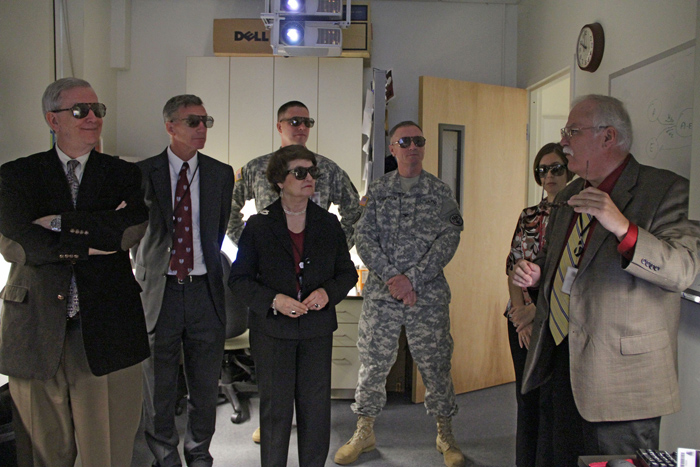USAMRICD hosts visitors from USUHS

The U.S. Army Medical Research Institute of Chemical Defense, Aberdeen Proving Ground, Md., hosted a visit from Charles L. Rice, M.D., president of the Uniformed Services University of the Health Sciences April 15. Rice was accompanied by his chief of staff, retired Col. Robert J. Thompson, and Dr. Ada Sue Hinshaw, dean of the USUHS Graduate School of Nursing. Col. Bruce Schoneboom, USAMRICD commander, invited Rice and his staff to the institute, and to APG South, to explore ways of increasing collaboration and sharing of information.
"The visit from Dr. Rice, Col. Thompson and Dr. Hinshaw is a great opportunity to talk about ways to synergize the research across our two agencies," said Schoneboom.
Schoneboom presented the guests with an overview of the institute's mission, capabilities, and research programs before accompanying them on a tour of several laboratories. The tour focused on two particular programs ' bioscavengers and reactivators ' to develop medical countermeasures to reduce or eliminate the toxic effects of nerve agent exposure.
Dr. Tamara Otto of the Analytical Toxicology Division provided an overview of the bioscavenger program, the main objective of which is to engineer enzymes or other moieties to bind and detoxify organophosphorus compounds, for example, chemical warfare nerve agents, as they enter and distribute through the circulatory system. Otto described the protective efficacy of the original stoichiometric bioscavenger human butyrylcholinesterase and explained more recent efforts focused on identifying catalytic bioscavengers, which unlike their predecessors can continue to bind to and hydrolyze nerve agent molecules, thereby rapidly destroying the organophosphorus compounds. She described how variants of paraoxonase-1 and organophosphorus hydrolase are being investigated as candidate catalytic scavengers.
Donald Maxwell and Richard Sweeney of the USAMRICD Research Division briefed the visitors on the reactivator program, using a 3-D stereoscopic visualization of a one-nanosecond molecular dynamics simulation, which was calculated on the Department of Defense high performance supercomputer cluster located at the Army Research Laboratory. The calculations simulated a molecule of the oxime HI-6 reactivating a molecule of VX-inhibited acetylcholinesterase.
Additionally, the guests received a briefing on emerging threats and countermeasures, and they toured the USAMRICD replacement facility being constructed adjacent to the institute's current campus.
After the briefings and tours at the USAMRICD, Rice and his staff continued their visit to APG South with stops at the Public Health Command, 20th Support Command, and Joint Program Executive Office for Chemical and Biological Defense.














